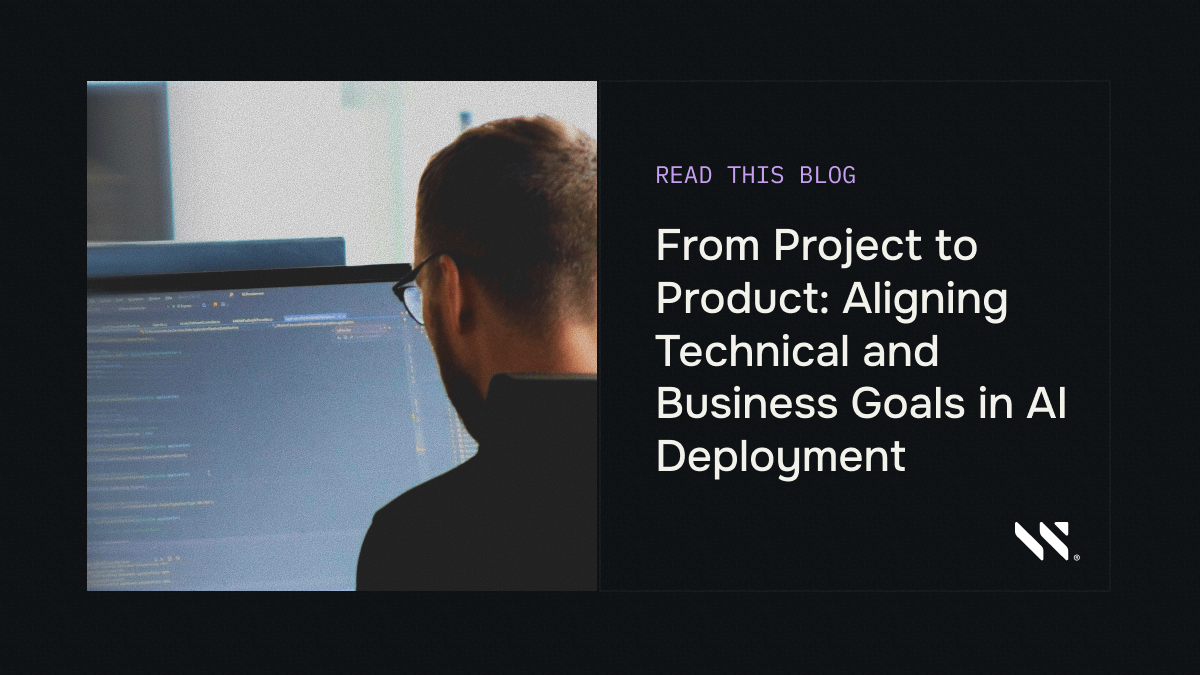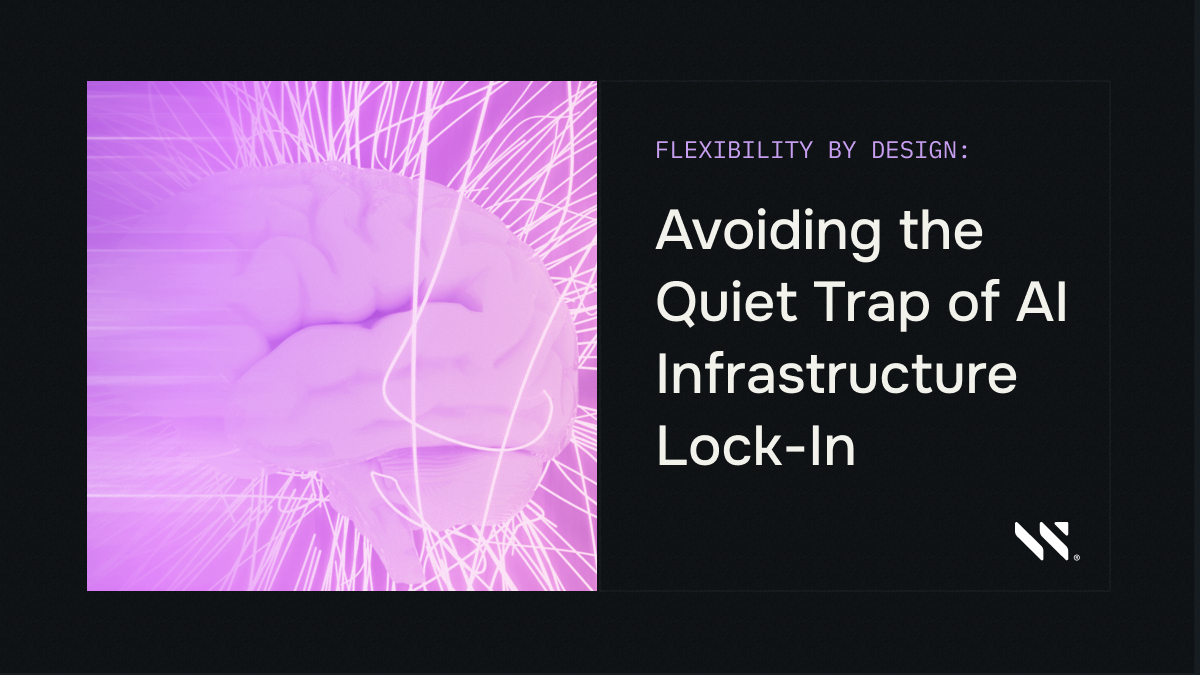The Business Value of Flexibility: Driving AI ROI with Smart Infrastructure


TL;DR I’ve lost count of how many times I’ve heard the same story: the model worked, but the economics didn’t. At production scale, every inefficiency—GPUs sitting idle, data pipelines choking, costs climbing faster than returns—shows up on the balance sheet. The teams that stay ahead are the ones who design for flexibility, so they can push tokens-per-second higher, bring cost-per-token down, and keep ROI moving in the right direction as workloads evolve.
The last three months in AI have felt like the longest three years in business. New workloads arrive faster than most infrastructure can adapt, and every shortfall shows up on the balance sheet. In training, GPUs sit idle waiting on data, driving utilization down and costs up. With inference, memory constraints and latency slow token throughput, breaking the real-time experience customers expect. Networking limits drag down performance, and storage systems buckle under scale. Proof-of-concept wins quickly turn into operational headaches.
According to MIT research, 95% of generative AI pilots at companies are failing to deliver expected business value. The core issue isn’t the quality of AI models, but the infrastructure’s inability to adapt to complex enterprise workflows and scaling demands.
Inference at scale only makes the pressure worse. What used to be a simple loop—input tokens in, output tokens out—has evolved into complex reasoning workflows that generate a massive volume of intermediate tokens.
The only way to stay ahead is flexibility. Build it into your infrastructure—or retrofit it later—and you can increase tokens per second, lower cost per token, and keep ROI moving in the right direction. Flexibility isn’t just a technical safeguard or technological experiment; it’s the foundation of making AI a business driver.
Where Technical Trade-offs Meet Business Goals
Technical trade-offs are constant in AI: GPU hours aren’t free, networking bandwidth has a cost, and storage performance sets real limits on how fast you can move. Apptio research shows that 58% of technology leaders cite uncertainty around AI ROI as their top challenge in making confident investment decisions. In a rigid environment, these trade-offs force you to pick your battles—prioritize one workload while others lag, or overspend to avoid falling behind.
Infrastructure that is flexible by design changes the math. It lets you:
- Reallocate resources on demand: Tune performance where it matters most without adding unnecessary cost or complexity.
- Eliminate waste: Future proof your investment by avoiding an environment that’s overpowered for some tasks and underpowered for others.
- Balance diverse workloads: Design your environment with tools that can deliver optimized performance that supports training, inferencing, and analytics in the same environment—without bottlenecks or constant redesign and reconfiguration.
These aren’t abstract technical wins—they are the choices that make sure every dollar spent brings real value. Because better resource utilization frees up time and budget for faster innovation, smarter customer features, and higher margins in competitive markets.
Flexibility as a Competitive Advantage
In real-world AI deployments, flexibility shapes how teams operate and how businesses grow. When infrastructure can shift with new workloads, teams are free to focus on getting new features out the door faster. IDC forecasts that AI infrastructure spending will surpass $200 billion by 2028, with 72% of spending going to cloud and shared environments as organizations prioritize flexible deployment models. Having the flexibility to adapt your infrastructure to evolving workload demands in real time means applications keep up with demand, even as data volumes and model complexity grow.
- Room to adapt: Markets shift, and new use cases emerge almost overnight. Without flexibility, each shift can feel like a massive overhaul. With it, you can respond in weeks, not quarters.
- Faster innovation cycles: When infrastructure can pivot with new workloads, teams spend less time wrestling with bottlenecks and more time shipping features that matter. VentureBeat reveals that 83% of organizations admit to not being able to fully utilize their GPU and AI hardware, even after system deployment.No more redesigning or redeploying infrastructure to accommodate new models or tuning for a single customer’s spike in demand.
- Better customer experiences: AI applications are only as good as the performance they deliver. Flexential’s 2024 State of AI Infrastructure Report found that performance issues tied to networking and data center scaling difficulties are holding back AI initiatives’ time to revenue. Flexibility lets you fine-tune resources in real time, so you’re not stuck explaining to customers why their experience is lagging.
A great example of flexibility in practice can be seen in the way Token Warehouses are reshaping the tokenomics of AI. The same optimized balance of GPU compute, high-speed/low-latency networking, and optimized storage that were originally designed to solve the challenges of AI training have been totally repurposed to meet the rising demand for token-efficient inferencing in use cases like Agentic AI and robotic swarms.
That’s why flexibility isn’t just a technical virtue—it’s a business imperative. The infrastructure that can absorb these shifts without a forklift rebuild is the one that drives ROI.
| 💡 Companies that built their AI products on flexible infrastructure are adapting faster, innovating more, and meeting their customers where they are. Everyone else is falling behind—and paying the price. |
Turning Flexibility into ROI with NeuralMesh
As these workloads drive up I/O and data access requirements, the software-defined architecture of NeuralMesh™ makes it possible to dynamically support both fast model development and performant, large-scale token generation—without rebuilding the stack. And because this optimized architecture can be deployed on-premises, in the cloud, or across hybrid environments, it ensures that AI performance remains efficient and responsive wherever your business needs it to run.
Unlike legacy systems that slow down as they scale, NeuralMesh actually gets stronger—feeding on growth to deliver faster performance, tighter resilience, and lower costs at exabyte scale.
That matters because ROI lives and dies in the details:
- In training, every idle GPU is wasted capital. NeuralMesh keeps accelerators fully utilized, shortening epoch times and reducing the cost per experiment.
- In inference, every extra microsecond is a drag on user experience. With features like the Augmented Memory Grid, NeuralMesh pushes tokens-per-second throughput higher and cost per token lower, so inference pipelines can hit real-time demands without forklift upgrades.
And when customers need even more efficiency, NeuralMesh Axon fuses directly into GPU servers—turning storage and compute into a single converged layer. That means no waiting on networks, no costly re-architectures, just higher GPU utilization for training and near-memory speeds for inference.
Proof in Action: Stability AI
A great example comes from Stability AI, the team behind Stable Diffusion. They needed to move fast in the ultra-competitive generative AI market but were burning money on idle GPUs and runaway cloud costs. By deploying NeuralMesh Axon on AWS, they turned that equation around:
- 93% GPU utilization efficiency – no more waiting on I/O bottlenecks.
- 95% reduction in cost per TB – massive storage savings.
- 35% faster model training – shaving weeks off innovation cycles.
- Lower carbon footprint – more efficient use of existing resources.
As Richard Vencu, MLOps Lead at Stability AI, put it:
“We can now reach 93% GPU utilization when running our AI model training environment using WEKA on AWS.”
That’s the business value of flexibility in action: faster model delivery, lower cost per token, and a sustainable infrastructure that grows stronger as demands increase.
How to Get There
Building flexibility into an AI deployment—whether you’re starting fresh or retrofitting existing systems—comes down to the right design choices:
- Invest in modularity: Gartner infrastructure research shows that balancing legacy infrastructure with modernization is top of mind for IT and Operations leaders. A key here is to avoid one-size-fits-all solutions that lock you into a single vendor’s ecosystem. Treat compute, networking, and storage as distinct elements that can evolve independently. Leverage technologies that can innovate and adapt to advancements in compute, networking and storage while improving business outcomes and efficiencies.
- Make it portable: Design workflows that can run on-prem, in the cloud, or in GPU-as-a-service environments without rewriting your entire stack. Gartner forecasts worldwide public cloud spending to reach $723 billion in 2025, with organizations increasingly attracted to hybrid and multicloud environments. This opens up options to respond to cost, performance, and market shifts.
- Embrace software-defined tools: Use software-defined platforms that abstract hardware dependencies and expose performance knobs that let you fine-tune resources to match workload needs.
- Benchmark in production-like conditions: Lab tests are a start, but real-world traffic and data volumes uncover the bottlenecks that matter most. Build observability and benchmarking into your deployment cycle, not as a one-time exercise. This allows you to understand and optimize your technology challenges and relate them to the tuning of your business outcomes.
- Plan for continuous change: AI doesn’t stand still. Gartner’s 2025 AI Hype Cycle identifies AI agents and AI-ready data as the two fastest advancing technologies, experiencing heightened interest and ambitious projections. Build processes—and teams—that can adapt as models evolve and new tools emerge.
These are the building blocks of flexibility. They’re not one-size-fits-all rules, but they are the mindset that keeps your infrastructure aligned with your goals, even as those goals shift.
ROI Starts with Flexibility
Technical excellence and business outcomes are two sides of the same coin. In AI, flexibility is what binds them together. It’s how you get the most out of your GPUs, your data, and your people—today and as everything keeps evolving.
Whether you’re designing from scratch or working with what you have, the decisions you make about flexibility set the tone for how well your deployment performs and how quickly it can respond to what’s next.
Because in the end, flexibility isn’t a feature. It’s the strategy that turns infrastructure from a cost center into a competitive advantage.Wherever you are in your AI journey, WEKA can help you move faster, smarter, and with less friction. Learn how NeuralMesh delivers the flexibility, performance, and control your workloads demand.





